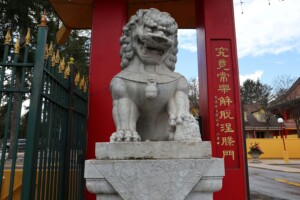
Within the Feng Shui world, there is some confusion about what is a “traditional” remedy vs. a folk remedy. There is also some cross-over between these two camps.
A traditional remedy is based on using some item which can manipulate air currents, usually called “qi flow.” These can be very mundane remedies, like putting up a fence, wall or hedge to divert the direct path of qi toward a house from an oncoming street. A free-standing screen inside a house could simultaneously re-direct the qi flow as well as block a bad view.
A traditional remedy could also be based on Five Element Theory, such as diagnosing a house first, based on when it was built and its compass alignment. This reveals what kind of unseen magnetic field exists in each directional zone of a floor plan. With that information, the practitioner knows what areas of the house need one of the Five Elements (Water, Wood, Fire, Earth, Metal) as a corrective addition to the area.
A traditional remedy may also include recommendations for how the person should use a room, how to position a desk or bed and that may be partly personalized with the individual’s birth data, marital status or occupation.
A folk remedy could be something that comes from Chinese culture and might be placebo-based. A folk remedy might also come from some spiritual practices, such as with Taoism, and integrated into a feng shui context. When we hear about “lucky charms” and talismans, used as Feng Shui remedies, they can be called “folk” remedies. These items are often placed ritualistically and superstitiously, for protection or for improved personal luck.
There are too many folk remedies to list here, but a few popular ones include:
- Image of a red peony flower for love luck
- Use of bamboo for long life
- Images of certain fish or other animals because the words for these creatures may also sound like something desirable. What could be an English-based equivalent? My mind is percolating on this one, but let’s say as one example that the word “dove” sounds almost like “love.” Would images of doves manifest more luck in love?
- An image of a toad with a coin in its mouth for wealth luck (even better if the toad is made of jade because jade is associated with money).
Some feng shui remedies came from traditional Feng Shui (or Chinese astrology), but have been watered down to appear more like magic or superstitions. For example, a person born in the year of the Ox can find support from a person born in the year of the Rat and vice versa. Initially we are talking about real people in friendly relationships. The watered down version of that would be if a person born in the year of the Ox wore a little “rat” pendant for a necklace. We have the 19th century adage, “An apple a day keeps the doctor away.” Do you think a picture of an apple would have the same health benefits?
Another example of what may have been traditional, but turned into folk remedy is the use of fish as feng shui remedies for wealth luck. It may have started with the traditional understanding that water placed in the right location can attract more wealth, with circulating water better than still water.
Hence, before the use of electric pumps, people needed to use fish to move the water around. Instead of water being the source of the sought after energy, it is now misconstrued into believing it is all about the fish, the number of fish and their color, the name of the fish, and even pictures of fish in place of real fish in water. It’s like the game that children play where they whisper a word into another child’s ear and after ten kids have repeated the word, it turns into another word entirely.
Cross-over remedies which are both traditional and folk at the same time could include the use of a 6-rod metal wind chime. Wind chimes are not just for attracting good luck or chiming away bad luck. They are a legitimate “moving metal” remedy, which has been supplanted in modern life by such things as pendulum clocks, or the sound coming from piano strings.
This article was inspired by a client who wanted advice on when to place a remedy inside her house with soil from the outside. It would involve a little digging up of the soil (earth element) which would go inside a brass (metal element) pagoda statue. Here we can trace some Five Element Theory to the project because earth makes metal stronger in the Productive Cycle of the Elements. This is an example of a cross-over remedy.
Sometimes I see a folk remedy become a traditional remedy by accident. Here is one example: some houses need the earth element, a “virtual mountain” (when there is no real mountain) in front of their house to support the health and well-being of the occupants. The virtual mountain can be any earthen object that is at least a few feet high. This could include a planter box filled with soil, a boulder out front in the landscape or even a raised flower bed.
If a person was to place two large stone lion statues outside their front door (for protection as a folk remedy), they may unknowingly be adding a virtual mountain to a house that needs it. Win/win. The occupants increase their health and well-being, which could also include protection from intruders.
Author: Kartar Diamond
Company: Feng Shui Solutions ®
From the Feng Shui Theory Blog Series

